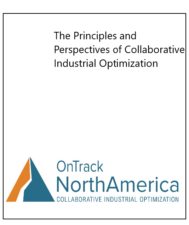Collaborative Industrial Optimization
What is now commonly called “supply chain optimization” is crippled by its own narrow focus, limited to individual company logistics. Consequently, neither the marketplace nor the public sector have been able to comprehensively plan infrastructure for efficient supply chain systems.
OTNA’s Collaborative Industrial Optimization re-conceives rail and freight infrastructure to serve entire industries and regions. The nation’s infrastructure investment must be guided by this whole systems approach to sustainable supply chains. Collaborative Industrial Optimization amplifies the economic and environmental benefits from infrastructure investment.
Key Distinctions of Collaborative Industrial Optimization
 1. COLLABORATION HAS A POWERFUL ROLE ALONGSIDE COMPETITION
1. COLLABORATION HAS A POWERFUL ROLE ALONGSIDE COMPETITION
Supply chains extend across county, state, regional, and national borders. Competition narrows the fundamental framework of engagement with others. Needed improvements flow from thinking and planning in collaboration with the other entities in the supply chain.
2. PLAN WHOLE SUPPLY CHAINS, NOT JUST PROJECTS
Infrastructure investments that support supply chain systems, rather than just individual projects, deliver key benefits to the region and its businesses and investors. Progressive economic development agencies now see greater success from systemic investments that connect the components of major supply chains.
3. PROJECTS OF NATIONAL SIGNIFICANCE ARE BUILT ON MANY PROJECTS OF LOCAL SIGNIFICANCE
The popular focus in national transportation investment on “Projects of National Significance” must be informed by the fact that there are no projects of national significance without many projects of local significance. The vision and scope of effective transportation planning and investment at every level must include as many regions, stakeholders, and projects as possible.
4. INCLUDING ALL PERSPECTIVES MAKES INFRASTRUCTURE DEVELOPMENT EASIER, NOT HARDER
Contrary to the prevailing belief that including all concerns and views is too complex, 360 degree inclusion of businesses, communities, and projects streamlines the productivity of infrastructure plans and investments. Transportation and supply chains are systems, best served when all parts are included in comprehensive growth and improvement plans.
5. PLANS ARE FOR ACTION
We can no longer invest in the type of “plans” that end up sitting ignored on government shelves and hard drives. Plans must be designed for implementation from the outset to the results.
6. STAKEHOLDERS ARE PARTNERS, NOT JUST SURVEY RESPONDENTS
Stakeholder engagement is often conducted as a superficial interaction to fulfill a bureaucratic requirement. Effective infrastructure investment requires collaborative dialogue and co-creation with all stakeholder groups.
7. RAIL AND ROADS ARE ONE SYSTEM
Integration and coordination for maximum efficiency must guide infrastructure planning and investment. It is unproductive to pit highway, air, pipeline, and railway transport modes against each other, either in public policy or the marketplace.
8. FREIGHT ANALYSIS MUST INCLUDE TRUCK DATA, EVEN IN RAIL PLANS
Truck shipment data provides critical visibility into the bulk of a region’s freight activity, illuminating the path toward an ideal truck-rail balance.
9. THE RIGHT TOOLS MAKE THE RIGHT DATA ACTIONABLE
Raw data is one level of usefulness; data made accessible and applicable is another. OTNA’s tools for data analysis enable stakeholders to use data for plan implementation as well as their own business development.
10. INTEGRATE FREIGHT PLANNING WITH ECONOMIC DEVELOPMENT
Across the country transportation departments and economic development agencies work in silos on matters that co-influence freight development. Collaborative Industrial Optimization integrates these efforts into regional freight strategies that make transportation enhancements feasible.
11. FREIGHT TRANSPORTATION IS INSEPARABLE FROM LAND USE PLANNING
Effective land-use planning optimizes economic development benefits while minimizing the impact of goods movement on communities and the environment. Proper use of land is as much about how goods and people move to and from a property, as what goes on at the property.
12. CAPITAL IS AVAILABLE FOR ALL WELL-CONCEIVED PROJECTS
Beyond seed funding, government does not have to bear the role of primary investor in freight infrastructure as transportation providers and shippers are engaged in private-sector, income-producing enterprise that can attract private-sector funding. Infrastructure investors and lenders now holding hundreds of billions of dollars are poised to deploy capital in freight projects when presented within a commercially savvy supply chain approach.
Learning from the Past
Early rail lines in 19th century North America were envisioned as part of expansive supply chains, from interior resources to coastal cities, from mine to factory, and from farm to table. Before individual  local projects were conceived and built, an entire corridor or region as a supply chain system was envisioned. Contrast that with 2008 at the height of America’s ethanol-production boom. Hundreds of billions in investment capital poured into the ethanol industry to fund individual “competing” projects. Unit train loading facilities, for example, were consequently built without matching unit train receiving facilities. Ethanol production skyrocketed while the ad hoc transportation and distribution system remained inadequate for meeting the nation’s important energy needs. Instead, OTNA’s Collaborative Industrial Optimization can ensure that capital and resources are now well-deployed toward the continent’s economic and environmental revitalization.
local projects were conceived and built, an entire corridor or region as a supply chain system was envisioned. Contrast that with 2008 at the height of America’s ethanol-production boom. Hundreds of billions in investment capital poured into the ethanol industry to fund individual “competing” projects. Unit train loading facilities, for example, were consequently built without matching unit train receiving facilities. Ethanol production skyrocketed while the ad hoc transportation and distribution system remained inadequate for meeting the nation’s important energy needs. Instead, OTNA’s Collaborative Industrial Optimization can ensure that capital and resources are now well-deployed toward the continent’s economic and environmental revitalization.

